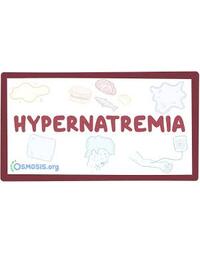Feeling salty? Let's look at Hypernatremia!

Diagnosis requires measurement of serum sodium and sometimes other laboratory tests(1). Treatment is usually controlled water replacement. When the response to treatment is poor, testing (eg, monitored water deprivation or administration of vasopressin) is directed at detecting causes other than decreased water intake.
Hypernatraemia reflects a deficit of total body water (TBW) relative to total body sodium content. Because total body sodium content is reflected by extracellular fluid (ECF) volume status(2), hypernatraemia must be considered along with status of the ECF volume:
- Hypovolemia
- Euvolemia
- Hypervolemia
Note that the ECF volume is not the same as effective plasma volume. For example, decreased effective plasma volume may occur with decreased ECF volume (as with diuretic use or haemorrhagic shock), but it may also occur with an increased ECF volume (eg, in heart failure, hypoalbuminemia, or capillary leak syndrome)(1).
Hypernatremia usually involves an impaired thirst mechanism or limited access to water, either as contributing factors or primary causes. The severity of the underlying disorder that results in an inability to drink in response to thirst and the effects of hyperosmolality on the brain are thought to be responsible for a high mortality rate in hospitalised adults with hypernatraemia(2,5).
Principal causes of hypernatraemia include diarrhoea, vomiting, burns, excessive sweating, intrinsic renal disease, loop diuretics and osmotic diuresis (glucose, urea, mannitol)(1,4). The most common cause of hypernatraemia due to osmotic diuresis is hyperglycaemia in patients with diabetes. Because glucose does not penetrate cells in the absence of insulin, hyperglycaemia further dehydrates the ICF compartment. The degree of hyperosmolality in hyperglycaemia may be obscured by the lowering of serum sodium resulting from movement of water out of cells into the ECF (translational hyponatremia). Patients with renal disease can also be predisposed to hypernatraemia when their kidneys are unable to maximally concentrate urine(3).
Hypernatraemia is common among the elderly, particularly postoperative patients and those receiving tube feedings or parenteral nutrition. Other contributing factors may include the following:
- Dependence on others to obtain water
- Impaired thirst mechanism
- Impaired renal concentrating capacity (due to diuretics, impaired vasopressin release, or nephron loss accompanying aging or other renal disease)
- Impaired angiotensin II production (which may contribute directly to the impaired thirst mechanism)
Replacement of both intravascular volume and free water is the main goal of treatment. Oral hydration is effective in conscious patients without significant GI dysfunction. In severe hypernatraemia or in patients unable to drink because of continued vomiting or mental status changes, IV hydration is preferred. Hypernatraemia that has occurred within the last 24 hours should be corrected over the next 24 hours. However, hypernatraemia that is chronic or of unknown duration should be corrected over 48 h, and the serum osmolality should be lowered at a rate of no faster than 0.5 mOsm/L/h to avoid cerebral oedema caused by excess brain solute(1,6).
In patients with hypernatraemia and hypovolemia, particularly in patients with diabetes with nonketotic hyperglycaemic coma, 0.45% saline can be given as an alternative to a combination of 0.9% normal saline and 5% D/W to replenish sodium and free water(6).
References
- https://www.merckmanuals.com/professional/endocrine-and-metabolic-disorders/electrolyte-disorders/hypernatremia?query=Overview%20of%20Electrolytes
- https://www.merckmanuals.com/home/hormonal-and-metabolic-disorders/electrolyte-balance/overview-of-electrolytes
- https://www.medicalnewstoday.com/articles/153188.php
- https://medlineplus.gov/fluidandelectrolytebalance.html
- https://www.rcpa.edu.au/Manuals/RCPA-Manual/Pathology-Tests/S/Sodium
- https://www.roswellpark.org/cancertalk/201808/electrolytes-what-are-they-what-happens-if-you-dont-have-enough
Hypernatraemia is a serum sodium concentration >145 mmol/L. It implies a deficit of total body water relative to total body sodium caused by water intake being less than water losses. A major symptom is thirst; other clinical manifestations are primarily neurologic (due to an osmotic shift of water out of brain cells) including confusion, neuromuscular excitability, seizures, and coma.




